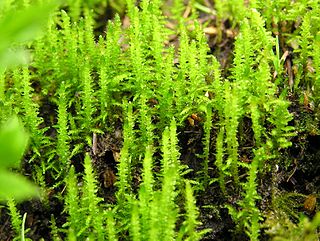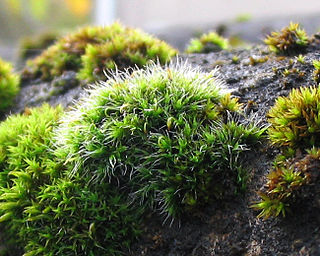
Physcomitrium is a genus of mosses, commonly called urn moss, that includes about 80 species and has a cosmopolitan distribution. The scientific name comes from the Ancient Greek words physa, meaning bladder, and mitrion, meaning little turban, which together refer to the urn-like calyptra. The common name is derived from its symmetrical, erect and urn-like capsules that lack peristomes, these features characterising the genus. They are commonly found on exposed soils that are often associated with locations that become very wet in the spring, such as along river banks or on alluvial mud. They occur from near sea level to about 2500 metres. The capsules mature over the winter and into the spring.

Bryology is the branch of botany concerned with the scientific study of bryophytes. Bryologists are people who have an active interest in observing, recording, classifying or researching bryophytes. The field is often studied along with lichenology due to the similar appearance and ecological niche of the two organisms, even though bryophytes and lichens are not classified in the same kingdom.
Ptychostomum warneum, known as sea bryum or Warne's threadmoss, is a protected moss found in sandy coastal areas in temperate regions of Europe and is also recorded to have been found in the Himalaya, the Altai Mountains and in Quebec, Canada.

Tetraphidaceae is a family of mosses. It includes only the two genera Tetraphis and Tetrodontium, each with two species. The defining feature of the family is the 4-toothed peristome.
Pohlia scotica, commonly known as Scottish threadmoss, is a moss endemic to Scotland. The earliest records date to 1964 and this moss was recognised as a distinct species in 1982. The largest populations are in Argyll with smaller populations in Dunbartonshire and Easter Ross. Its favoured habitat is silt, sand and gravel subject to regular inundation. The species has been provisionally classified as Lower Risk and receives protection under the Wildlife and Countryside Act 1981.
Bryum dixonii, commonly known as Dixon's threadmoss, is a moss endemic to Scotland. The species occupies montane habitats, and although rare it has a wide distribution including the central and north-west Highlands, and the islands of Skye, Rùm and St Kilda. Originally discovered on Ben Narnain, Argyll, in 1898 by Hugh N. Dixon, it was not seen again until 1964 when found by Ursula Duncan at Juanjorge in Glen Clova in Angus. As of 2000 there was no species action plan for its protection.
Marsupella arctica, commonly known as Arctic rustwort, is a species of liverwort found in the Northern Hemisphere. It is present in Alaska and Greenland and has a European distribution confined to Scotland and Svalbard. The Scottish population was first discovered in 1989 and is restricted to two sites in the Cairngorm mountains - the Lairig Ghru and Beinn a' Bhùird.

Hypnum cupressiforme, the cypress-leaved plaitmoss or hypnum moss, is a common and widespread species of moss belonging to the genus Hypnum. It is found in all continents except Antarctica and occurs in a wide variety of habitats and climatic zones. It typically grows on tree trunks, logs, walls, rocks and other surfaces. It prefers acidic environments and is fairly tolerant of pollution. It was formerly used as a filling for pillows and mattresses; the association with sleep is the origin of the genus name Hypnum.

Platyhypnidium riparioides, the long-beaked water feathermoss, is a species of aquatic moss commonly found in many regions. This species is among the largest aquatic mosses growing up to 15 cm long. P. riparioides grows in a procumbent or pendulous fashion along rocks and tree roots and may form extensive lax mats of many intermingled plants. It is widely distributed South of the Arctic and can grow abundantly in suitable areas.

Pellia epiphylla is a species of thallose liverwort. It occurs in North America, Europe, North Africa and parts of Asia. It grows in patches in damp, sheltered places on neutral or acidic substrates. It is common on the banks of rivers, streams and ditches and also grows in wet woodland, marshes and on wet rocks.

Anthoceros agrestis, commonly called field hornwort, is a bryophyte of the genus Anthoceros. It has complicated taxonomies.

Dicranum scoparium, the broom forkmoss, is a species of dicranid moss, native to most of the northern hemisphere as well as Oceania. It usually forms and grows in round mass clumps or mats on soil in dry to moist forested areas. As with many types of moss Broom moss grows in clumps with Broom mosses as well as other mosses. It can be distinguished by its leaves, which strongly curve to one side.

Bartramia pomiformis, the common apple-moss, is a species of moss in the Bartramiaceae family. It is typically green or glaucous in hue, although sometimes it can appear yellowish. The stems extend from a half cm to 8 cm, with narrowly lanceolate to linear-lanceolate leaves 4 – 9 mm long. The leaves have a nerve and are toothed. They are curled when dry but stick out when moist.

Phaeoceros laevis, the smooth hornwort, is a species of hornwort of the genus Phaeoceros. It is commonly found in areas where moisture is plentiful, such as moist soils in fields, the banks of streams and rivers or inundated beneath the surface of the rivers. It grows to a maximum height of about 5 millimetres and the plants are monoecious; the sex organs are visible on the dorsal surface.

Calliergon cordifolium is a species of moss in the Calliergonaceae family, commonly known as the calliergon moss or heart-leaved spearmoss. The species is abundant in the right habitat, and grows in marshes and wet woodland, especially woodland of alder (Alnus) or willow (Salix), as well as around streams, ditches and pools. The species grows in tufts among other moss species. Calliergon cordifolium requires a wet environment to grow, and often grows completely submerged in water. It typically prefers lowland, but has been recorded as high as 910 metres (1,000 yd) above sea level in Inverness, Scotland. The species has a circumpolar Boreo-temperate distribution. It is found throughout Europe. It has been recorded in north and central Asia, as well as Turkey and Japan, throughout North America and in New Zealand.

Palustriella commutata, commonly known as curled hookmoss, is a plant that also goes by the binomial names Cratoneuron commutatum, Cratoneuron falcatum, Hypnum commutatum, and Hypnum falcatum.

Mylia taylorii, or Taylor's flapwort, is a species of leafy liverwort.

Sphagnum fimbriatum, the fringed bogmoss, is a slender Sphagnum moss.

Rhizomnium punctatum, also called dotted thyme-moss, is a small species in the genus Rhizomnium.

Grimmia pulvinata, otherwise known as grey-cushioned grimmia or pulvinate dry rock moss, is a bryophyte moss common in temperate climates worldwide.
















